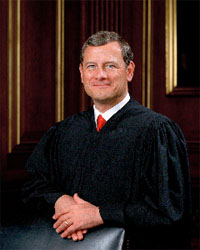Religious bias cases at high court

Chief Justice John Roberts (Photo credit: Steve Petteway, Collection of the Supreme Court of the United States)
The battle lines between the constitutional right to free exercise of religion and laws prohibiting discrimination are seeing some action at the U.S. Supreme Court these days.
A decision this month by the Supreme Court shot holes in the government’s ability to insist that church-based employers obey laws prohibiting discrimination based on disability. Such laws have been important to many in the LGBT community because they have prohibited discrimination against people with HIV infection, breast cancer, and in some cases, gender identity disorder.
Meanwhile, for the second time in two years, a student religious group is hoping to assert its First Amendment right to exclude students who don’t embrace its religious beliefs. In 2010, the high court upheld the right of the University of California-San Francisco’s Hastings College of Law to deny official campus group status to a Christian student group, Christian Legal Society (CLS). But the decision seemed to signal the conservatives’ willingness to rule differently with another set of circumstances and this new case could do just that.
In Hosanna-Tabor v. EEOC, a unanimous Supreme Court ruled January 11 that the First Amendment bars lawsuits on behalf of “ministers” against their “churches.” Supreme Court coverage veteran Lyle Denniston characterized the opinion as allowing a “ministerial exception” to “federal, state, and local laws against virtually all forms of discrimination on the job.”
But Lambda Legal did not offer a brief in the case, and Gay & Lesbian Advocates & Defenders called the decision “probably right.”
“We let churches govern themselves without government interference, and it is really part of that fundamental principle that the government should not force a religion to retain a ‘minister’… that the religion does not want,” explained Gary Buseck, GLAD’s legal director. “Chief Justice Roberts seemed to try to make this case about as narrow as possible in that the decision is limited to employment discrimination claims and expressly says it is not addressing other types of claims that might be brought.”
Key questions in the deliberation were whether employee-plaintiff Cheryl Perich was, in fact, a “minister” and how willing the courts would be to let church employers decide for themselves if and when an employee is “ministerial.”
Perich brought a lawsuit against her employer, the Lutheran-run Hosanna-Tabor Evangelical Lutheran Church and School. She sought help from the U.S. Equal Employment Opportunity Commission in pressing her claim that the school had violated the federal Americans with Disabilities Act (ADA) when it refused to give her back her job after she had been on leave for a disability (narcolepsy) for a few months.
The ADA prohibits employment discrimination based on disability, and the EEOC filed suit on her behalf. But the church school argued that the First Amendment guarantee of free exercise of religion bars government intervention against a church in its relationship with a minister.
A federal district court in Michigan agreed with the school; but the Sixth Circuit U.S. Court of Appeals sided with the EEOC and Perich, stating that Perich’s duties as a “minister” were identical to those when she had as a lay teacher.
The unanimous Supreme Court, however, considered Perich to be “one of the group’s ministers.”
The First Amendment and prior high court rulings, noted Chief Justice John Roberts, who wrote the opinion, have confirmed that it is “impermissible for the government to contradict a church’s determination of who can act as its ministers.”
“Until today,” noted Roberts, “we have not had occasion to consider whether this freedom of a religious organization to select its ministers is implicated by a suit alleging discrimination in employment.”
There were a couple of interesting political ironies in the Roberts’ opinion. First, he did not apply a “strict constructionist” view of the constitution in which a conflict is to be examined against the explicit original text of the constitution.
In his opinion, Roberts stated that the First Amendment gives “special solicitude to the rights of religious organizations.”
“We cannot accept the remarkable view that the Religion Clauses have nothing to say about a religious organization’s freedom to select its own ministers,” wrote Roberts.
But the constitution does not say anything explicitly about the selection of ministers. It says, “Congress shall make no law respecting an establishment of religion, or prohibiting the free exercise thereof.”
Second, Roberts cited foreign law—something conservatives routinely rail against—to illustrate a point. He said the clash between church and state over “religious offices is hardly new.” And, he discussed how the Magna Carta of 1215 promised the King of England would not impair the rights of the English church.”
But it is hard to squabble with the statement that the conflict between church laws and state laws has been a long-standing battle. And the conflict between those who wish to discriminate against others and claim a free exercise right to violate laws prohibiting discrimination—in particular, laws prohibiting discrimination based on sexual orientation and gender identity—is escalating.


What’s obviously going to happen now is that “churches” will start to call their employees “ministers” and pretend that that they all have religious functions. And so the country smilingly walks into becoming a theocracy
Steve – Rest assured, some of us will go kicking and screaming. Let’s hope we get some funding for our schools and, in particular, for the sciences. Perhaps, we can stem the flow of this tendency to believe in magical thinking. If we don’t, we are headed back to the days of the Flat Earth Society.